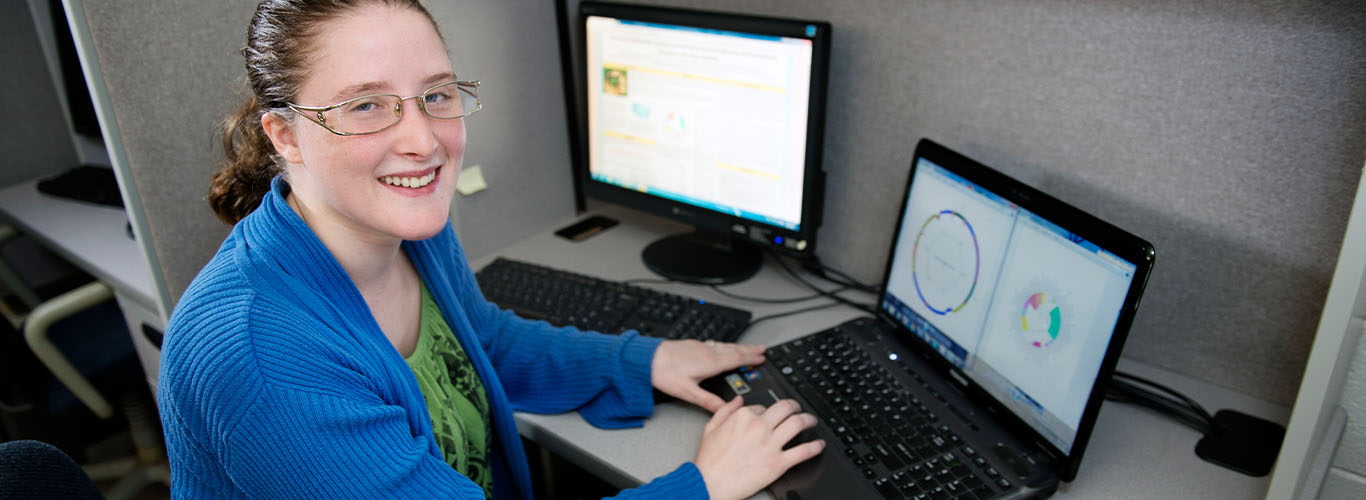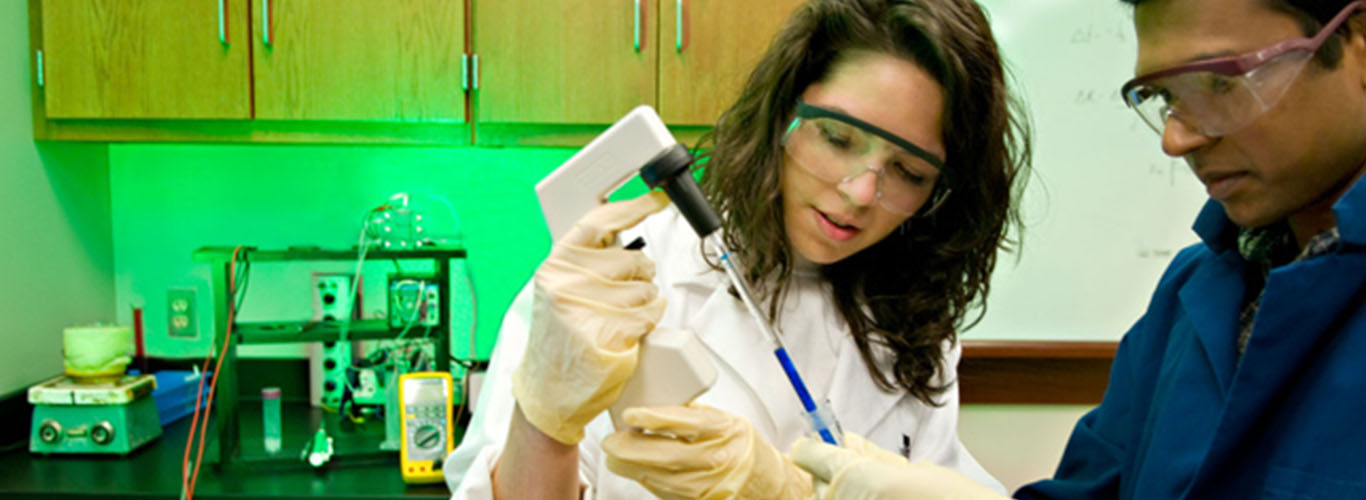- Home |
- REU Projects
REU Projects
Biomaterials
(1) Optimization of Osteochondral Xenograft
Faculty Mentor: Steve Elder
Project Description: My lab is developing an acellular porcine osteochondral xenograft to repair focal cartilage lesions in the knee [1]. The aims of the project are 1) Determine methods of processing the tissue to achieve efficient antigen removal; 2) Characterize the effects of antigen removal on biomechanical properties, enzymatic resistance, etc.; 3) Investigate approaches to crosslinking the tissue to mask residual antigen, reinforce it mechanically, and prevent rapid enzymatic degradation; 4) Explore methods of cytokine/growth factor immobilization and sustained release; 5) Observe the response of cells to the xenograft in vitro, as well as cartilage and bone regeneration in vivo in various animal models. These aims involve procedures such as DNA assay, Western blot, immunostaining, mechanical testing, measuring degree of crosslinking, and aseptic cell culture. REU students will participate in all phases of the project.
(2) Exploration of Mg alloys for bone fracture fixation
Faculty Mentor: Lauren Priddy
Project Description: Stabilization of bone defects after traumatic injury or tumor resection is a significant clinical challenge. Despite advances in therapeutics, the materials used for fixation of bone during healing are often cumbersome and require subsequent surgeries for removal. For many clinical applications, including bone fracture/defect fixation, tuning the rate of biomaterial degradation with the rate of new tissue formation is desirable. Internal fixation devices (e.g., screws, pins, rods) are typically made of stainless steel or titanium and often require surgical removal, which can increase patient morbidity and is controversial, especially for pediatric patients who have not reached skeletal maturity [2]. The objective of this work is to assess biomaterials for bone fracture fixation; in particular, Mg alloys (e.g. MgCa0.8, AZ31) will be explored. Mg alloys are advantageous over traditional metallic biomaterials for their biocompatibility and mechanical properties that more closely match native bone [3], thus limiting stress shielding and bone resorption. The degradation (corrosion) and mechanical properties of Mg alloys throughout the degradation process will be evaluated via micro-CT and torsional testing, respectively. Although small volumes of Mg have shown good biocompatibility, larger and/or faster degrading alloys may be immunogenic [4, 5], so in vitro assays will serve as screening tools to observe the effects of Mg alloy byproducts on cell viability. Ultimately, the study of these materials will contribute to the development of biologically degradable fixation devices that mimic bone mechanical properties to stabilize large bone defects.
(3) Structure-property relationships of adipose tissue
Faculty Mentor: Lakiesha Williams
Project Description: Fat Tissue, also known as adipose tissue, is mainly comprised of loose connective tissue and is located below the dermis layer. The main function of adipose tissue is thermal Insulation, energy storage, shock absorption, and muscle movement [8]. The structural and mechanical properties of adipose tissue is multi-layered and Isotropic in nature. Adipose Tissue is made up of lipid filled cells known as adipocytes. Adipose tissue of healthy adults contain one third of the mature adipocytes. Each Adipose Cell consists of one lipid vacuole, a nucleus and a phospholipid bilayer and is supported by two collagen based structures. Mainly type I and type IV collagen is found in adipose tissue [9]. Adipose tissue just beneath the skin, which is also known as subcutaneous region, is a soft connective tissue made up of a collagen fiber network [9]. The unique arrangement of fat tissue lends to it's ability to absorb shock at high rates. The objective of this study is to quantify the mechanical properties of and correlating structure of adipose tissue in an effort to inform the design of engineered system's whose focus is to mitigate high stresses.
(4) Engineering Microenvironments for Cardiovascular Disease Modeling
Faculty Mentor: Renita Horton
Project Description: The cellular microenvironment plays a central role in oraganogenesis and disease development. Biomolecules, mechanotransductive cues, extracullar matrix proteins, and cell-cell interactions dictate cellular maturation and cell behavior. We propose to use biomimetic microsystems to investigate cell-cell interactions that contribute to vascular occlusions. We hypothesize that we can create a physiologically relevant vascular model to investigate blood-endothelium interactions during chronic inflammation. In our studies, we will use extracellular matrix proteins to create a mechanically tunable, biomemetic microsystem to investigate cellular interactions that lead to blood flow interruptions. The goal of this study is to understand the contribution of mechanical cues from the extracellular matrix to endothelial dysfunction and vascular occlusions. Students will perform mechanical testing, computer modeling, microscopy, and cell culture techiques to address the aims of this project.
(5) Cell Therapy for Vascular Calcification
Faculty Mentor: C. LaShan Simpson
Project Description: Vascular calcification is the precursor for numerous heart disease conditions including myocardial infarction, stroke, and etc. Vascular calcification was once thought to be an end-stage passive process but has more recently been recognized as an active remodeling process involving cells and proteins. The calcification process of medial vascular calcification has been shown to be the phenotypic switching of smooth muscle cells (SMCs) native to the arteries to become osteoblast-like (OBL) cells. In addition to the notion that SMCs undergo a phenotypic switch to become OBL cells, vascular calcification has been linked to bone mineralization in other ways. Explanted calcified arteries have been examined and bone cells (osteoblasts (OBs) and osteoclasts (OCs)) were found in addition to fully formed bone matrix consisting of hydroxyapatite. These excised diseased tissues also expressed bone markers. Our hypothesis is that vascular calcification can be controlled through the same mechanisms that regulate bone formation. This project will be the development of an injectable OC delivery to reverse vascular calcification. We will use polymer microbeads to encapsulate cells. The polymer will protect the cells from immunorejection in vivo and allow for delayed release of the cells.
(6) Comparison of Stabilizers for Nanoprecipitation of Oil Red O
Faculty Mentor: Priscilla Hill
Project Description: Many new pharmaceuticals are poorly water soluble, which makes them difficult to formulate [14]. A promising approach to solving this problem is to formulate the drug as a nanoparticle dispersion [15]. In these experiments antisolvent precipitation will be used to create nanoparticles. This method uses a solvent solution of the desired compound and an aqueous solution of a stabilizer, and then mixes the two solutions together. Two significant factors in this method are the choice of the solvent and the stabilizer. Previous Oil Red O nanoprecipitation experiments by an REU student mentored by Dr. Hill showed that PVP can be used as a stabilizer when isopropanol is the solvent, but the nanoparticles agglomerated with time. The goal of this project is to investigate other stabilizers to produce a more stable dispersion. The parameters to be varied will include the stabilizer type, the concentration of stabilizer in the aqueous solution, and the ratio of solvent solution to aqueous solution. The nanocrystals will be characterized by a TEM available on campus. It is expected that this will be a series of projects where each student will study a set of stabilizers, and where other solvents may be considered. Each REU student will be responsible for preparing and characterizing nanoparticles of Oil Red O, and contributing to the design of experiments. Dr. Hill will train the student in the procedures and ensure that safety procedures will be followed.
Composites and Polymers
(7) Self-assembly of Low Molecular Weight and Polymeric Gelators
Faculty Mentor: Santanu Kundu
Collaborator: Neeraj Rai
Project Description: Gels are used in many applications including in biomedical, and food [16, 17]. Gels that are formed by physical assembly of gelators are of particular interest, as these gels can be potentially formed and dissociated on-demand by the application of mechanical stress or stimuli. To achieve such goal a detailed understanding of self-assembly process of gelators into gel like structure is necessary. We are interested in gelators molecules such as triblock copolymers (ABA type) in midblock selective solvents, and low-molecular weight gelators (LMWGs) consisting of Fmoc moieties [18-22]. In a midblock selective solvent, the end-blocks of the ABA copolymers associate to form gel [18-20]. Strength of these gels depends on the molecular weight of the blocks and solvent quality [18-20]. However, a detailed understanding of such relationship is still not achieved. In the case of LWMGs, the small molecules self-assemble into fibrils, platelets, or other structures through non-specific interactions such as -, dispersions, H-bonding [21, 22]. Chemical structure of the gelators and nature of the solvents play an important role in the self-assembly process of the gelator molecules and their stimuli-responsive behavior [21, 22]. Presently, we are investigating the self-assembly process of LMWGs with various chemical moieties in different solvents. The REU student in this project will investigate the self-assembly behavior of ABA copolymers, Fmoc systems in different solvents of interest over multiple length scales.
(8) Molecular Insights into Gelation Behavior of Molecular Gelators
Faculty Mentor: Neeraj Rai
Collaborator: Santanu Kundu
Project Description: Molecular gels are soft materials that find numerous applications including hydraulic fracturing, electronics, and separations [23-26]. Low molecular weight organic compounds (gelators, LMWG) when dissolved in solvents often aggregate to form one-dimensional fibers [22, 27]. These fibers form a three-dimensional self-assembled fibrillar network immobilizing solvent molecules to form molecular gels. The self-assembly process is governed by the weak interactions (dispersion, hydrogen bonding, and pi-pi interactions) present between gelator-gelator, gelator-solvent, and solvent-solvent. Despite the tremendous interest in this class of soft materials over the last two decades, our understanding of the gelation process is largely phenomenological [27]. We still do not fully understand why some low molecular weight compounds form molecular gels in certain organic solvents or water, while other structurally similar derivatives do not [27, 28]. The proposed research plan aims to provide answer to these fundamental questions with the use of advanced molecular simulation techniques and force fields. These research objectives will be accomplished by investigating gelation behavior of LMWGs with different functional scaffolds and solvent polarity. The REU student will conduct molecular dynamics and electronic structure calculations on selected gelator molecule and solvent combinations. The simulation findings will be corroborated with experiments conducted by our experimental collaborator.
(9) Molecular Dynamics Simulations of Polymer Fatigue
Faculty Mentor: Tonya Stone
Project Description: The main objective of this research project is to exploit molecular dynamics (MD) simulations to obtain the required material responses, particularly energy dissipation, from the nanoscale for inclusion in a macroscale predictive fatigue model. Preliminary results reveal that a macro-level fatigue life prediction model utilizing an energy‑based criterion is able to accurately capture the fatigue of polyether ether ketone (PEEK), an engineering-grade thermoplastic polymer that is frequently used in automotive, aerospace, and biomedical applications. The approach includes performing all-atom classical MD simulations on several initial amorphous, isotropic polymer models that consider several different chain lengths and various numbers of chains to study the effect of cyclic loading and frequency on the hysteresis of PEEK for fatigue life prediction. From the MD simulation results we will evaluate the dissipated strain energy under cyclic loading and its dependence to morphological, thermal, mechanical (loading level and frequency), and environmental factors. Because the material response of polymers is sensitive to the morphology of their molecular chains during loading, MD simulations will also be used to provide information on the internal mechanisms associated with the morphological structure of PEEK, including bond length, bond angle, dihedral distributions, change of free volume, and chain entanglements. We will explore the fundamental science of polymeric materials at the nanoscale and will gain a better understanding of the underlying fatigue deformation mechanisms. This approach can be extended to other polymeric systems for predicting their fatigue life using an energy-based criterion obtained from simulations, reducing the requirement of extensive experimentation.


